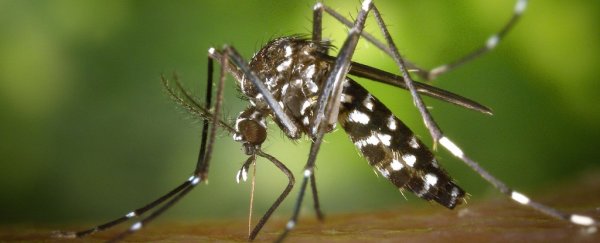In the space of just two years, scientists have virtually wiped-out the world's most invasive mosquito from two islands in the Chinese city of Guangzhou.
The mosquito species, known as the Asian tiger (Aedes albopictus), is a carrier of dangerous infectious diseases including Zika, dengue, and chikungunya, which affect millions of people worldwide. The insect is also notoriously difficult to control.
Over the past four decades alone, this wily blood-sucker has spread from its original home in Asia to every other continent on Earth, excluding Antarctica. With only limited vaccines and drug treatments for the diseases that it transmits, the mosquito's impact on public health has been disproportionate to its tiny size.
An exciting field test of an innovative mosquito control technique shows we have the potential to change all of that. By combining two existing methods, scientists reduced Asian tiger mosquito populations by up to 94 percent on two river islands in China. In some cases, not a single viable egg was found for up to 13 weeks.
In a recent review of the work, Peter Armbruster, a mosquito ecologist at Georgetown University, said the results were "remarkable" and that they demonstrate the "potential of a potent new tool in the fight against mosquito-borne infectious disease."
The two-pronged approach includes a dose of radiation, which sterilises the mosquitoes, and a bacterial strain from the Wolbachia genus, which prevents the mosquito eggs from hatching. Together, when these two methods are applied to lab-grown mosquitoes, they appear to work much more effectively than on their own.
Current radiation-based techniques work by releasing sterile male insects into the environment so that they breed with females (who only mate once), decreasing the overall size of their population. The problem is, irradiation tends to make these males less competitive sexually and also more likely to die.
Other methods that use bacteria to reduce offspring are less harmful to the individual mosquito, but they only work if the lab-grown male is infected and not the wild female. If both the male and female have the bacterial infection, they'll have no issue producing healthy offspring, making it a delicate balancing act.
As you can imagine, sifting through male and female insects in the lab is painstaking business, and even when scientists go to all this effort, the accidental release of Wolbachia-infected females happens about 0.3 percent of the time, undermining the entire mission.
The new solution, therefore, rears Wolbachia-infected mosquitoes in the lab and then subjects them to low levels of radiation, effectively sterilising any included females while leaving the males still able to reproduce.
Not only does this sound great in theory, it also appears to work in practice. By getting rid of the need for sex testing, the team could produce and release large numbers of these lab-grown mosquitoes - around two hundred million in total - in a city with the highest dengue transmission rate in China.
After two years, their findings demonstrate a nearly 97 percent decline in mosquito bites suffered by locals on the two islands. Plus, each year, the average number of wild-type adult females caught per trap dropped by 83 to 94 percent, with none detected for up to 6 weeks.
The few mosquitoes that remain on the island probably migrated from outside the study area, the authors say. And while this suggests that the region won't be mosquito-free for long, if the technique can be implemented on a larger scale, it could create a place free from Asian tiger mosquitoes and the deadly diseases that they carry.
"Our study predicts that the overall future costs of a fully operational intervention using this environmentally friendly approach will be around US$108 per hectare annually," says Zhiyong Xi, a microbiologist and molecular genetics professor at Michigan State University, "which seems cost-effective in comparison with other mosquito control strategies."
This study has been published in Nature.
